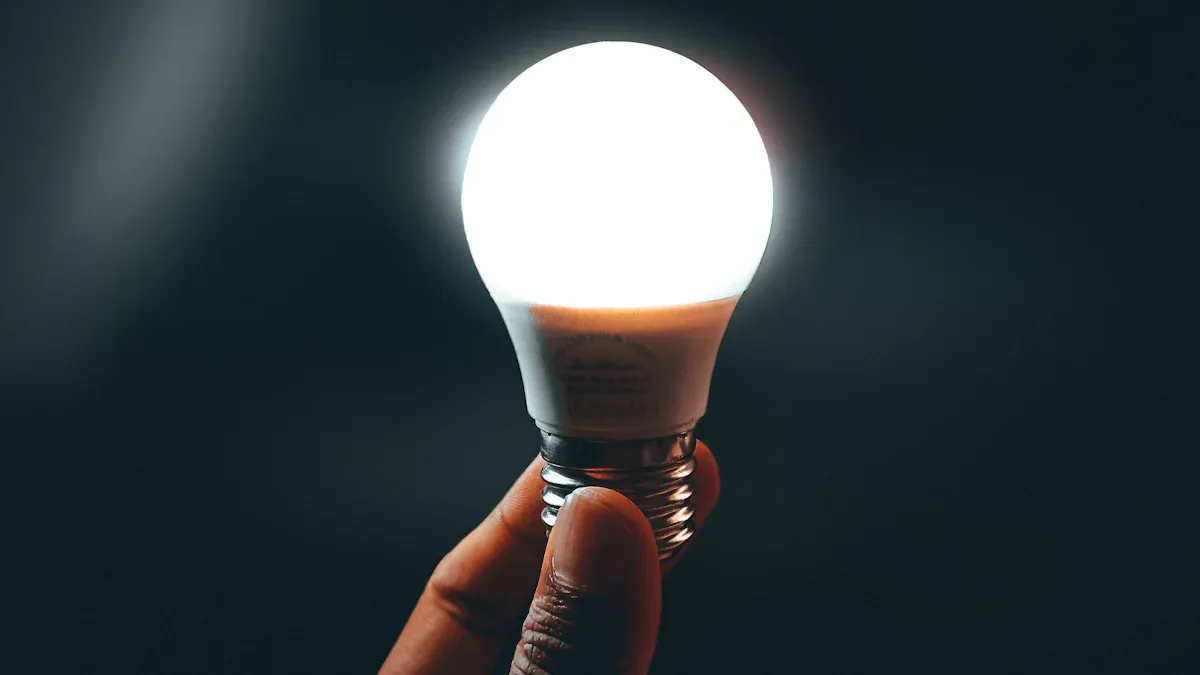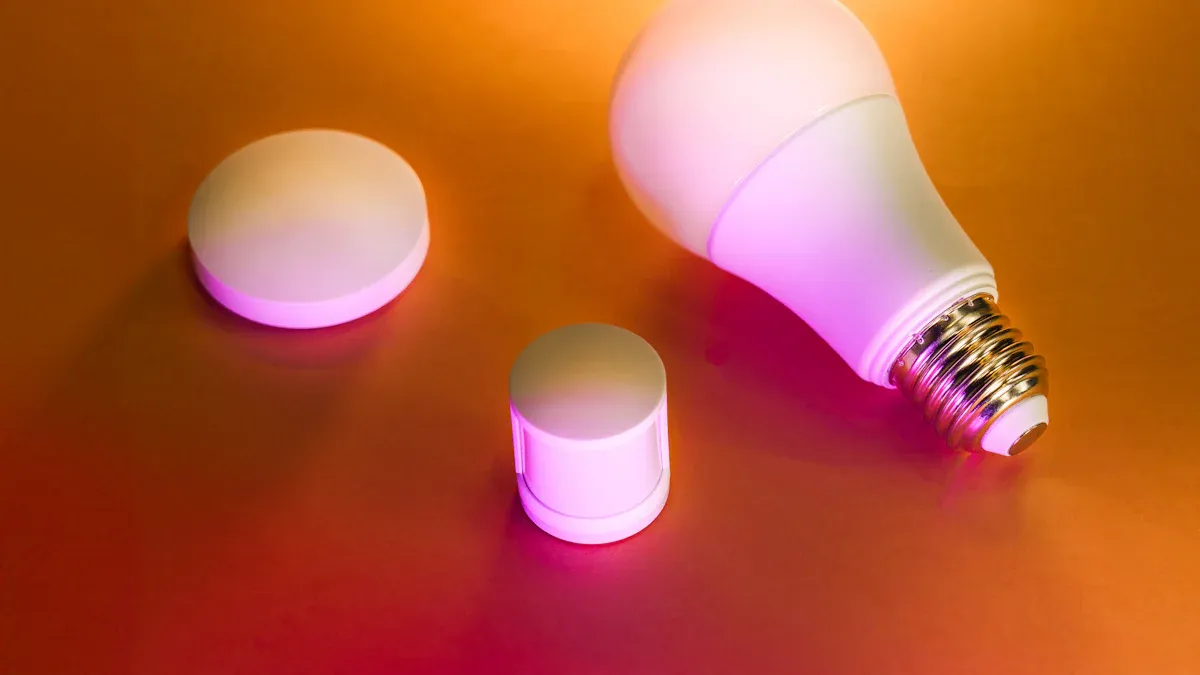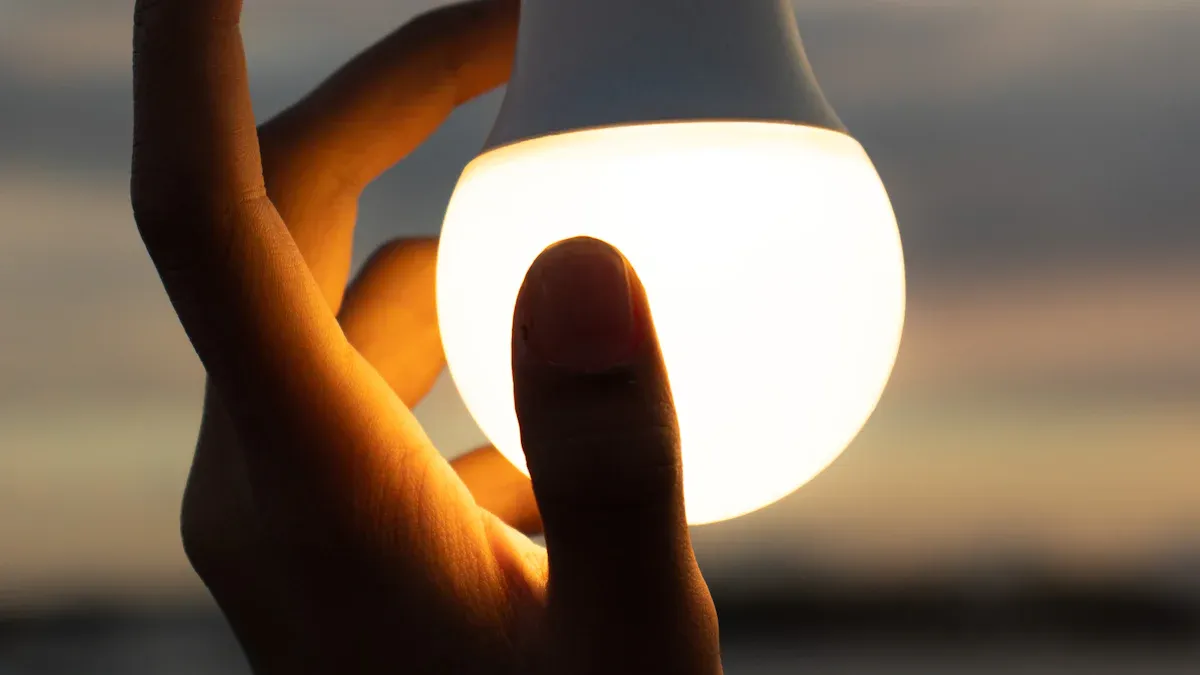LED Light Bulbs: Technology, Benefits, and Selection Tips

LED light bulbs are a superior choice for your home because they save energy and have a long lifespan. They provide 70 to 100 lumens per watt, significantly more than incandescent bulbs, which only offer 10 to 17 lumens per watt. By using LED bulbs, you can effectively lower your energy bills. With a lifespan of up to 25,000 hours, you won’t need to replace them frequently.
When selecting LED bulbs for your home, consider factors such as brightness, energy consumption, and longevity. Additionally, check the color temperature and compatibility with your fixtures. Understanding these aspects will help you make the best choice for your lighting needs. About us, we are committed to providing you with the best options in LED lighting for your home.
Key Takeaways
LED bulbs save energy and lower your bills. They use 80-90% less energy than traditional bulbs.
Choose LED bulbs based on lumens for brightness, not watts. This helps you find the right light for your needs.
LEDs last much longer than regular bulbs, shining for up to 25,000 hours. This means fewer replacements and lower costs.
Look for ENERGY STAR certification when buying LEDs. This ensures you get efficient and long-lasting bulbs.
Consider smart and dimmable options for added convenience. These features let you control lighting easily and save energy.
Understanding LED Light Bulb Technology

How LED Light Bulbs Work
LED bulbs use modern technology to make light efficiently. Unlike old bulbs with filaments or gases, LEDs (Light Emitting Diodes) create light using a semiconductor. When electricity flows through the semiconductor, it releases photons, which produce light. This method is very efficient because LEDs turn 95% of energy into light and lose only 5% as heat. This helps save electricity and lowers your energy costs.
LEDs also light up instantly without flickering or delays. They stay cool while working, making them safer for home use.
Key Features of LED Light Bulbs
LED bulbs have many great features that make them special. They can last up to 25,000 hours, which is 25 times longer than regular bulbs. This means you won’t need to replace them often. They also use at least 75% less energy than traditional bulbs, making them better for the environment.
LEDs come in different shapes and sizes, like A19 for general use or BR30 for ceiling lights. You can pick from various color temperatures, measured in Kelvin (K). For example, warm white (2,500-3,000K) gives a cozy feel, while daylight (5,000-6,500K) is great for bright tasks. Some LED bulbs even have smart features, letting you control them with your phone or voice.
Differences Between LED and Traditional Bulbs
LED bulbs are better than traditional ones in almost every way. They use much less energy but give the same brightness. For example, a 10-watt LED shines as bright as a 60-watt incandescent bulb. LEDs also stay cooler, making them more energy-efficient and safer to touch.
Here’s a simple comparison:
Feature | LED Bulbs | Incandescent Bulbs |
|---|---|---|
Lifespan (hours) | 25,000+ | 1,200 |
Energy Use (watts) | 4-28 | 40-150 |
Heat Produced (BTUs/hr) | Low (3) | High (85) |
Strength | Strong | Breakable |
Harmful Materials | None | None |
Switching to LEDs saves money and helps the planet. Their strength and lack of harmful materials make them a safer, greener choice for your home.
Benefits of LED Light Bulbs

Energy Efficiency and Cost Savings
LED bulbs use much less energy than old-style bulbs. They save up to 90% on electricity, cutting your bills. For example, running an LED for a year costs $1.61. In comparison, an incandescent bulb costs $9.64. Over time, these savings grow. A family can save about $100 yearly by switching to LEDs. Businesses can cut energy costs by 60-70%.
Here’s a simple cost comparison:
Bulb Type | Watts | Monthly Use (kWh) | Monthly Cost ($) | Monthly Savings ($) |
|---|---|---|---|---|
Incandescent (100W) | 100 | 24 | 3.60 | |
LED (15W) | 15 | 3.6 | 0.54 | 3.06 |
LEDs cost more upfront but save money quickly. You can recover the cost in 1-2 months. This makes them a smart choice for homes and businesses.
Longevity and Durability
LED bulbs last much longer than regular ones. Incandescent bulbs burn out after 1,200 hours. LEDs can shine for up to 25,000 hours. This means fewer replacements and lower upkeep costs. Some LEDs have an L70 rating, showing how long they stay bright. These ratings range from 20,000 to 60,000 hours.
LEDs are also tough. They are made with strong materials, so they resist shocks and bumps. Good airflow and quality parts help them last longer. But heat or bad use can shorten their life. To make them last, use LEDs in well-ventilated fixtures.
"LEDs are built to last, but proper care helps them shine longer."
Environmental Advantages
Using LED bulbs helps the planet. They use less power, which lowers the need for energy plants. This reduces greenhouse gases. By 2027, using LEDs could save 348 TWh of electricity. That’s like the power from 44 big power plants. It could also save over $30 billion in costs.
LEDs create less waste. Their long life means fewer bulbs in landfills. Unlike fluorescent bulbs, LEDs have no harmful chemicals like mercury. This makes them safer to throw away and better for the Earth. LEDs also cut down on light pollution, offering a greener lighting option.
Choosing LEDs means saving energy and helping the environment at the same time.
Versatility and Design Flexibility
LED bulbs are very flexible and can be used anywhere. They work well for cozy homes or busy commercial spaces. These bulbs easily match your needs.
A big benefit of LED bulbs is their variety. They come in many shapes, sizes, and styles. You can pick the right one for your space. For example, LED strip lights highlight features, while recessed LEDs give a modern look. Their small size makes them great for creative uses like under-cabinet lighting or decorations.
LEDs let you change lighting to fit your mood or task. You can adjust brightness and color. Warm white light feels relaxing, while cool white is good for work. Some LEDs even let you pick colors like red, green, or blue for special events.
LED bulbs are useful in many places, as shown here:
Application Type | |
|---|---|
Residential | Saves energy, custom lighting, looks nice |
Commercial | Cuts costs, works better, creates welcoming spaces |
Smart Home Integration | Easy control, automation, fits user needs |
In smart homes, LEDs work with apps or voice commands. You can control them from anywhere. This makes them easy to use and modern. LED bulbs save energy, look stylish, and fit today’s needs.
"LED bulbs are more than lights; they help design amazing spaces.
Tips for Picking the Best LED Light Bulb
Knowing Brightness and Lumens
When buying LED bulbs, focus on lumens, not watts. Lumens show how bright a bulb is, making it easy to compare. For example, a 60-watt old bulb gives about 800 lumens. New LED bulbs need only 10-15 watts for the same brightness, saving energy.
Check the lumens on the box to pick the right brightness. For general lighting, choose 800-1,100 lumens. For tasks like reading or cooking, go for brighter bulbs. Always pick based on lumens to get the light you need without wasting power.
💡 Tip: Look for the Lighting Facts label on the box. It shows lumens, watts, and energy costs.
Picking the Right Color Temperature
The color of light changes how a room feels. Measured in Kelvins (K), it shows if light is warm, neutral, or cool. Lower numbers, like 2,700K-3,000K, give a warm, cozy glow. These are great for bedrooms or living rooms. Mid-range, around 3,500K-4,100K, gives neutral light, good for kitchens or offices. Higher numbers, like 5,000K-6,500K, look like daylight and work well for reading or detailed tasks.
Think about the room’s purpose when picking a bulb. Use warm white for relaxing spaces. Use cool white or daylight for focused tasks. Some LED bulbs let you change the color temperature, giving you more options.
🌈 Note: A high Color Rendering Index (CRI) of 80+ makes colors look natural under the light.
Checking Energy Labels and Certifications
Energy labels help you find good, efficient LED bulbs. Look for ENERGY STAR-certified bulbs. These meet strict rules for saving energy and lasting longer, helping you save money. In Mexico, the NOM-030-ENER-2016 standard ensures bulbs meet energy-saving rules.
The Lighting Facts label is also helpful. It shows brightness, energy use, and yearly costs. Pick bulbs with high lumens per watt for better efficiency. Many modern LEDs give over 100 lumens per watt, making them a smart energy choice.
Certification Standard | What It Means |
|---|---|
ENERGY STAR | Proves the bulb saves energy and works well. |
NOM-030-ENER-2016 | Sets energy-saving rules for LED bulbs in Mexico. |
✅ Pro Tip: Certified bulbs save energy and last longer, giving you great value.
Ensuring Compatibility with Fixtures
Before buying LED light bulbs, make sure they fit your fixtures. Not all bulbs work with every fixture, so checking is important. First, find out the base type of your fixture. Common bases include E26 (screw base) and GU10 (twist-and-lock). Match the bulb's base to your fixture to avoid problems.
Next, think about the fixture's design. Enclosed fixtures, like ceiling domes or outdoor lanterns, can trap heat. Some LED bulbs aren’t made for these and might overheat. This can shorten their life. Look for bulbs labeled "safe for enclosed fixtures" if needed.
Voltage is another thing to check. Most home fixtures use 120 volts, but some need low-voltage bulbs. Check the voltage on both the bulb and fixture to ensure they match. Using the wrong voltage can cause damage.
Lastly, consider the fixture's purpose. For dimmable fixtures, pick dimmable LED bulbs. For decorative fixtures, choose bulbs with the right shape, like candle-shaped LEDs for chandeliers. By checking these details, you’ll avoid issues and enjoy great lighting.
💡 Tip: Always read the box or product details to confirm the bulb works with your fixture.
Considering Dimmable and Smart Options
Dimmable and smart LED light bulbs offer more features and save energy. Dimmable bulbs let you change brightness to match your mood. Use dim light for relaxing or bright light for tasks. Lower brightness also uses less power, saving energy.
Smart bulbs make lighting even easier. They connect to Wi-Fi or Bluetooth, so you can control them with an app or voice commands. You can set schedules, change brightness, or pick colors from anywhere. Some smart bulbs save up to 80% energy by adjusting light based on time or room use.
When picking smart bulbs, think about what you need. White tunable bulbs let you change color temperature. Multicolor bulbs offer millions of colors. Both types often include dimming. These features are great for mood lighting or smart home setups.
🌈 Note: Smart bulbs cost more at first, but their energy savings and cool features make them worth it.
Switching to LED light bulbs has many benefits. These bulbs use 80-90% less energy, last up to 50,000 hours, and help lower greenhouse gases. Their smart features, like remote control and sensors, make them a modern choice.
Feature | Benefit or Fact |
|---|---|
Energy Efficiency | Uses 80-90% less energy than older bulbs |
Lifespan | Works for 15,000 to 50,000 hours |
Environmental Impact | Lowers greenhouse gas emissions |
Smart Technology | Offers remote control and sensor options |
Market Growth | Expected to reach $160 billion by 2026 |
Energy Savings Potential | May cut global lighting electricity by 40% by 2030 |
Cities like Los Angeles already see the benefits. They replaced 140,000 streetlights with LEDs, cutting energy use by 63%. This saved $9 million yearly and reduced maintenance and carbon emissions.
Now is the perfect time to switch. LEDs save money, cut your carbon footprint, and offer advanced lighting. Check out LED options today to make your home or workplace more eco-friendly.
FAQ
Why are LED bulbs more energy-efficient than older bulbs?
LED bulbs turn 95% of energy into light. Only 5% becomes heat. Older bulbs waste most energy as heat. This makes LEDs save power and cut your bills.
💡 Tip: Using LEDs can lower your energy costs by 90%.
Can I use LED bulbs in any fixture?
Not all LED bulbs fit every fixture. Check the base type to match your fixture. For enclosed fixtures, pick LEDs marked "safe for enclosed spaces" to prevent overheating.
🔧 Note: Always check voltage to avoid damage.
Are LED bulbs good for the environment?
Yes, LEDs are eco-friendly. They use less power, cutting greenhouse gases. Unlike fluorescent bulbs, LEDs have no harmful chemicals like mercury, making them safer to throw away.
🌍 Fact: Switching to LEDs can greatly reduce your carbon footprint.
Can LED bulbs work with dimmer switches?
Some LED bulbs can dim, but not all. Look for "dimmable" on the box. Use them with the right dimmer switches for smooth dimming.
⚙️ Pro Tip: Use dimmers made for LEDs to stop flickering.
How do I pick the right brightness for a room?
Look at lumens, not watts. For general lighting, choose 800-1,100 lumens. For tasks like reading, go for brighter bulbs. Match lumens to the room’s purpose.
💡 Reminder: The Lighting Facts label helps you compare brightness easily.
See Also
Exploring GE LED Bulbs: Key Features And Selection Advice
Understanding Industrial LED Bulbs: Efficiency And Usage Insights
The Ultimate Resource For LED Bulbs And Their Advantages
